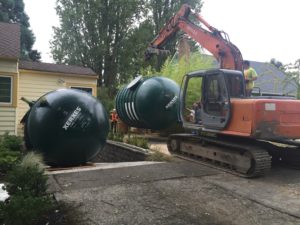 RainBank is experiencing increased interest in underground storage for our Seattle customers, requiring special considerations for underground water storage tanks.
RainBank is experiencing increased interest in underground storage for our Seattle customers, requiring special considerations for underground water storage tanks.
Aesthetics and available space are the most common reasons from these customers. Many are building larger homes on small lots that once had a 1,200 square foot home with a front and back yard. New construction is trending towards a larger footprint, leaving less room for water storage tanks. Slimline tanks allow for less visual impact, but are restrictive on volume. Other residents are remodeling older existing homes that still have yard space available – and are looking for greater amounts of storage. Below grade storage can be the answer, leaving a yard area that can accept landscaping right over the top of the water tanks.
Here are some things to consider with underground storage.
- First and foremost – costs. Below grade storage will require excavation and. most likely, exporting much of that soil, which would have to be loaded and trucked off site.
- Drainage needs to taken in account, with the new City of Seattle stormwater rules preferring infiltration for overflow. Where infiltration is not feasible, connection to the city storm system can be implemented for overflow as long as caution is taken to prevent sewer gases or back flow from entering the tank.
- Water tanks need to be properly vented and have a riser to access the tank for periodic cleaning and pump service. The installer must be sure that plumbing will not be compromised with slight settling or shifting of the tank.
- Below grade tanks tend to be more expensive to meet engineering requirements of underground tanks, and once installed, are considered a confined space and caution must be taken if access is necessary.
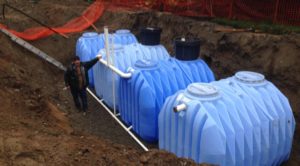 For those who understand the considerations of underground storage, you have the luxury of landscaping that is free of visual impact and have different available options in tank sizes, styles, and materials. Tanks can be single or multiple, plastic or fiberglass. Cement tanks can be used for non potable use or lined with a NSF certificate for drinking water.
For those who understand the considerations of underground storage, you have the luxury of landscaping that is free of visual impact and have different available options in tank sizes, styles, and materials. Tanks can be single or multiple, plastic or fiberglass. Cement tanks can be used for non potable use or lined with a NSF certificate for drinking water.


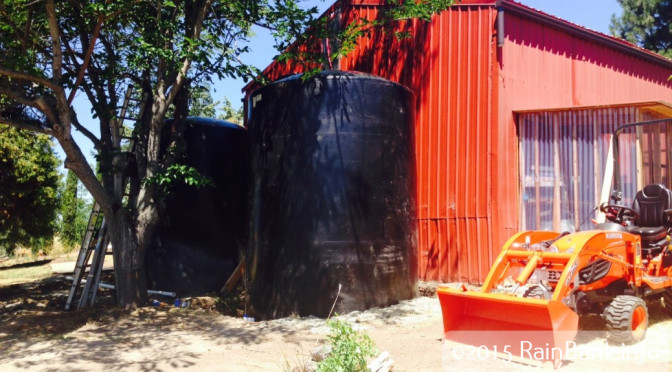
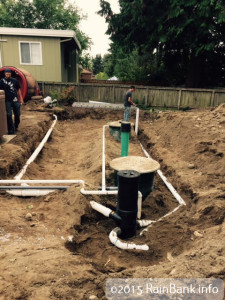 Buried tanks have less visual impact than that of above ground tanks. Careful planning and engineering is required for this type of installation. Care must be given to surrounding vegetation and tree root systems. Grading and drainage requirements must be met so impact is reduced.
Buried tanks have less visual impact than that of above ground tanks. Careful planning and engineering is required for this type of installation. Care must be given to surrounding vegetation and tree root systems. Grading and drainage requirements must be met so impact is reduced.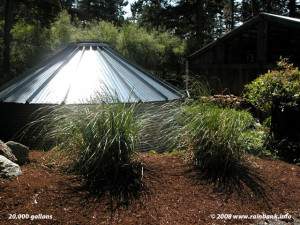 Steel tanks generally can have increased volume and are usually constructed in more of a rural environment. Steel tanks require an engineered slab and must meet seismic requirements. Many find that the industrial look is aesthetically pleasing.
Steel tanks generally can have increased volume and are usually constructed in more of a rural environment. Steel tanks require an engineered slab and must meet seismic requirements. Many find that the industrial look is aesthetically pleasing.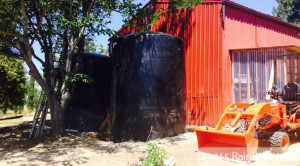 Plastic tanks (top and right) are the most cost effective and come in many sizes from 50 gallons to 10,000 gallons. Multiple tanks can be manifolded together. While most are guaranteed for UV protection, shading from the sun will increase longevity of the tank.
Plastic tanks (top and right) are the most cost effective and come in many sizes from 50 gallons to 10,000 gallons. Multiple tanks can be manifolded together. While most are guaranteed for UV protection, shading from the sun will increase longevity of the tank.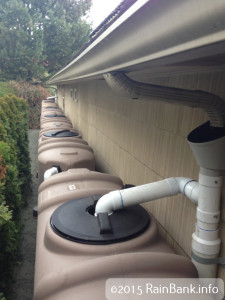 Slimline tanks offer a compact install for the urban customer, requiring little area for storage. They can be connected together to increase volume.
Slimline tanks offer a compact install for the urban customer, requiring little area for storage. They can be connected together to increase volume.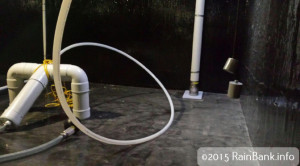 And finally, cement vault storage under the dwelling can be achieved with proper engineering. This type of storage allows a large volume with no visual impact or area used up for the cistern other than below the structure itself. Care must be given structurally, as well as moisture and condensation concerns need to addressed.
And finally, cement vault storage under the dwelling can be achieved with proper engineering. This type of storage allows a large volume with no visual impact or area used up for the cistern other than below the structure itself. Care must be given structurally, as well as moisture and condensation concerns need to addressed.